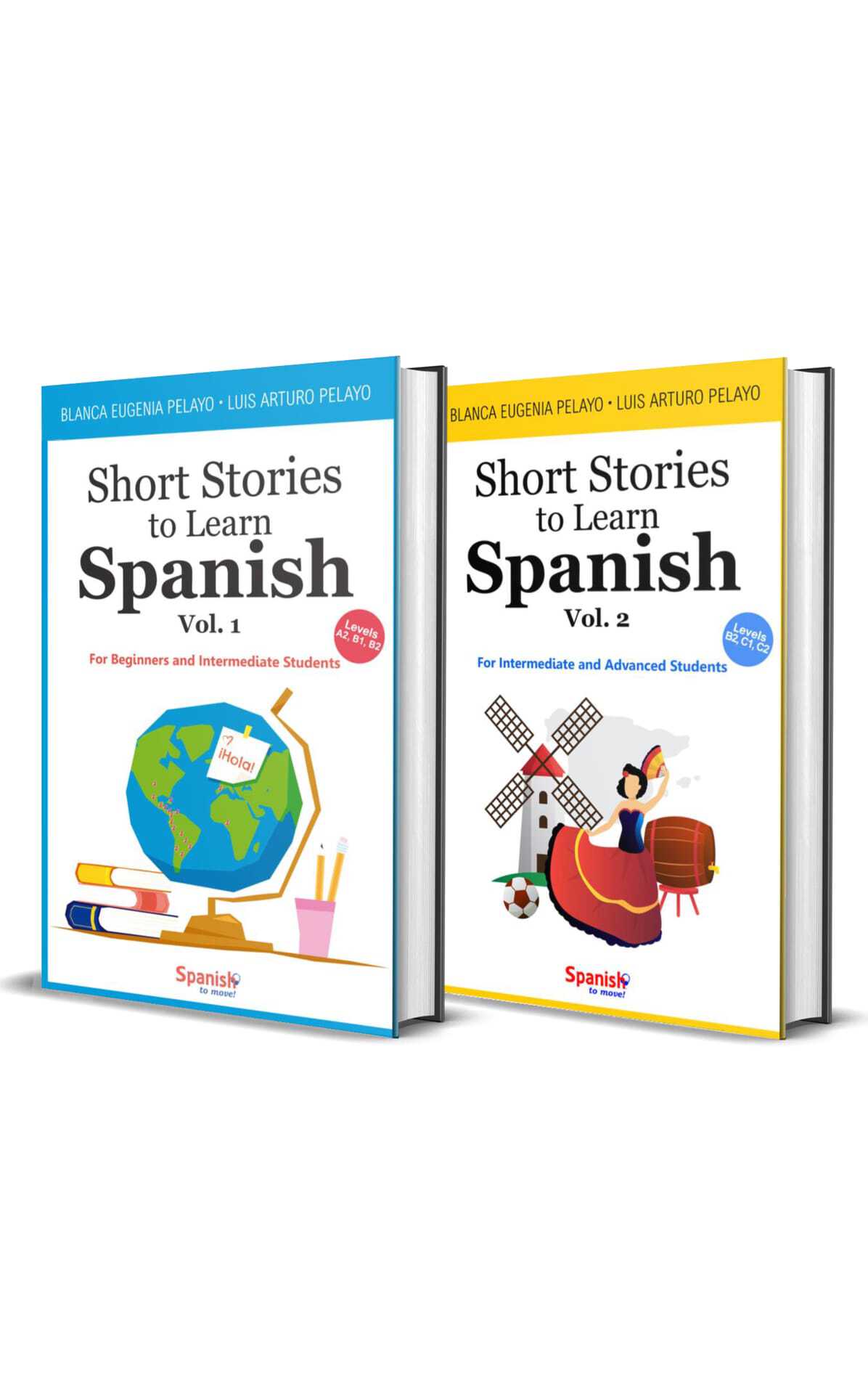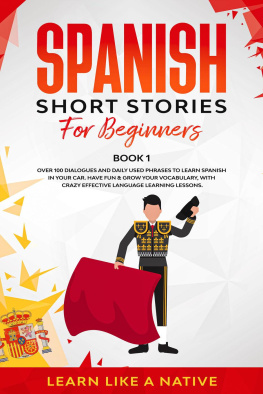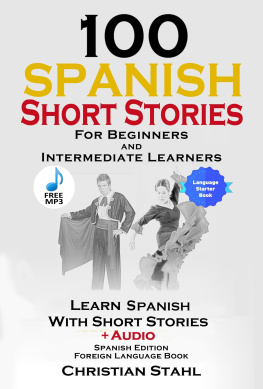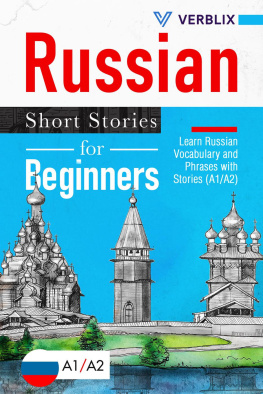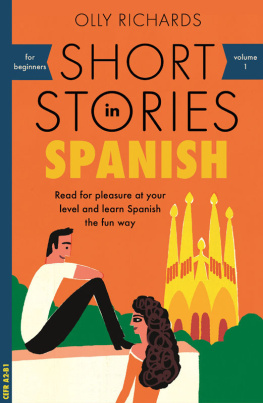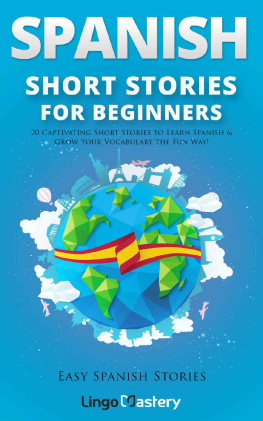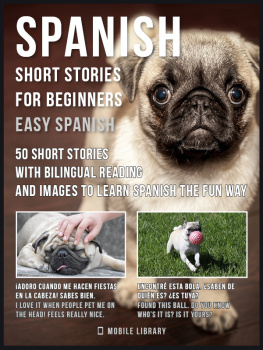Short Stories
to Learn
Spanish
Vols. 1 & 2
Blanca Eugenia Pelayo
Luis Arturo Pelayo
Spanish To Move
Mexico 2020
Copyright 2020 Blanca Eugenia Pelayo Gutirrez
Copyright 2020 Luis Arturo Pelayo Gutirrez
Copyright 2020 Spanish To Move
Cover image and illustrations: Freepik
All rights reserved.
No part of this book may be reproduced or transmitted in any form, by any means, without written permission from the authors.
www.spanishtomove.com
Contenido
Introduction
Spanish is a dominant language in the West and it is spoken by almost 500 million people around the world. It is also the second mother tongue in the world by number of speakers, after Mandarin Chinese, and the second most studied language in the worldin 2019, the number of people studying Spanish as a second language was more than 22 million. Moreover, in 2060, the United States will be the second Spanish-speaking country in the world.
However, for most adults, learning Spanish can be daunting, because most of the programs are focused on memorizing difficult grammar rules, verb conjugations, and endless lists of words. Furthermore, students are forced frequently to use boring textbooks and have to take stressful exams to evaluate their proficiency.
Spanish To Move was founded in 2013under the slogan Learn Spanish Online: Its Time to Move Forward! as an online platform for helping people learn Spanish in an easy and effortless way. Our programs were designed by experts, on the basis of psychological and linguistic research, to ensure effective and long-lasting learning, under the direct (natural) method of teaching, developed to immerse the learner in Spanish in the same way as the learning of the mother-tongue: in a natural wayteaching is done in Spanish, grammar is taught intuitively, there is a focus on speaking and listening, and only useful everyday language is taught.
After several years of offering audio and video lessons online, we are now publishing Short Stories to Learn Spanish , where the readers will find interesting stories, written for beginner or advanced students, which will help them learn or practice their Spanish, acquire new vocabulary, and go over the most used grammar structures without even thinking about grammar. Also, by focusing on short texts, students will remain engaged, focused, and motivated when they achieve specific learning goals.
Vol. 1: For Beginners and Intermediate Students offers 39 stories written mostly in present, past, and future tenses, for beginner and intermediate studentslevels A2, B1, and B2 of the Common European Framework of Reference for Languages (CEFR).
Vol. 2: For Intermediate and Advanced Students comprises 50 stories for intermediate and proficient Spanish learnerslevels B2, C1, and C2 of the CEFRin virtually all the Spanish tenses, or at least the most used in everyday life.
These stories have been written in plain language, without technicalities or difficult vocabulary that requires continually looking up for words in the dictionary, and cover subjects such as history, philosophy, psychology, geography, biography, language and literature, and topics of general interest.
Our goal in writing these stories has been to help readers gradually progress in their knowledge of the Spanish language while reading stories on various topics of general interest.
Keep in mind that you don't have to study grammarat least at the beginningto learn a foreign language. When we focus on grammar, we analyze the language and we think about the verb tenses and the correct way to place the elements that are used in speech. This works if one is trying to write a letter, for example. But when our goal is to speak a language, which is what most people are interested in, there is no time to think about grammar constructions or prepositions, much less when someone asks us a question and we need to give a quick response.
Grammar should be learned in the same way a native speaker of any language learns it: by reading and listening, again and again, to create subconscious patterns. Grammar needs repetition to record itself unconsciously in the brain. Many studies have shown that the key to effective learning is listening and reading.
In addition, research shows that, when learning a new language, students who read for pleasure make the most progress on vocabulary acquisition and are better at understanding grammar structures. Everything is easier when done for pleasure.
At the end of the day, we offer you this book intending to make your Spanish path fun and interesting. We hope that our goal is accomplished and that soon you can read and speak Spanish fluently.
Sincerely,
The authors
How to Use This Book
We have divided the book into short stories, which go from simple to more complex grammar structures and vocabulary. Each of them contains the following elements:
S PANISH T itle
English title . Grammar clues. (Vol. 1)
Story
Learning support features
(questions, additional vocabulary, etcetera)
1. Start with the Grammar Clues to understand what you will find in the story ( i.e. , what verb tenses are being used, if the story emphasizes a certain type of vocabulary or grammar aspect, etcetera).
2. Read the story and take note of the bold text (Vol. 1) , which will help you be aware of the grammar topic addressed in that specific story. Dont try to memorize anything. Your brain will create unconscious patterns by associating those words in bold .
[ Vol. 2 does not include bold texts, since intermediate and advanced students should be able to understand virtually all the ideas and words of a non-technical text and identify the different elements of a sentence: nouns, articles, adjectives, pronouns, adverbs, prepositions, conjunctions, and even interjections, as well as the different conjugations of verbs (in the indicative, subjunctive and imperative modes, both simple and compound tenses), non-personal forms of the verb (infinitive, participle, and gerund) and verbal voices (active and passive). Likewise, advanced Spanish students should be able to recognize implicit meanings, summarize information, and reconstruct arguments.]
Although each story covers some topics or tenses, other tenses may appear as well. However, they are not in bold font, so that you can focus your attention on the main grammatical aspects of that specific story.
If you dont understand some words, dont look for their meanings on the dictionary. Try to relate the unknown words to the rest of the story and deduct their meanings from the context. Consider that your goal is to understand between 70% to 90% of the story without looking for definitions on the dictionary.
Take advantage of the learning support features included in each story. In some cases you will find comprehension questions that will help you evaluate your understanding of key ideas; in others, you will find definitions of difficult words.
Practice speaking by reading aloud the stories. It is a great way to develop the ability to articulate, improve your pronunciation, and achieve fluency.
7. Finally, remember that you can find the audio lessons for these stories at www.spanishtomove.com , in case you want to hear how a native Spanish-speaker pronounces them, or in case you want to keep practicing by listening to the stories while you drive, exercise or rest.

